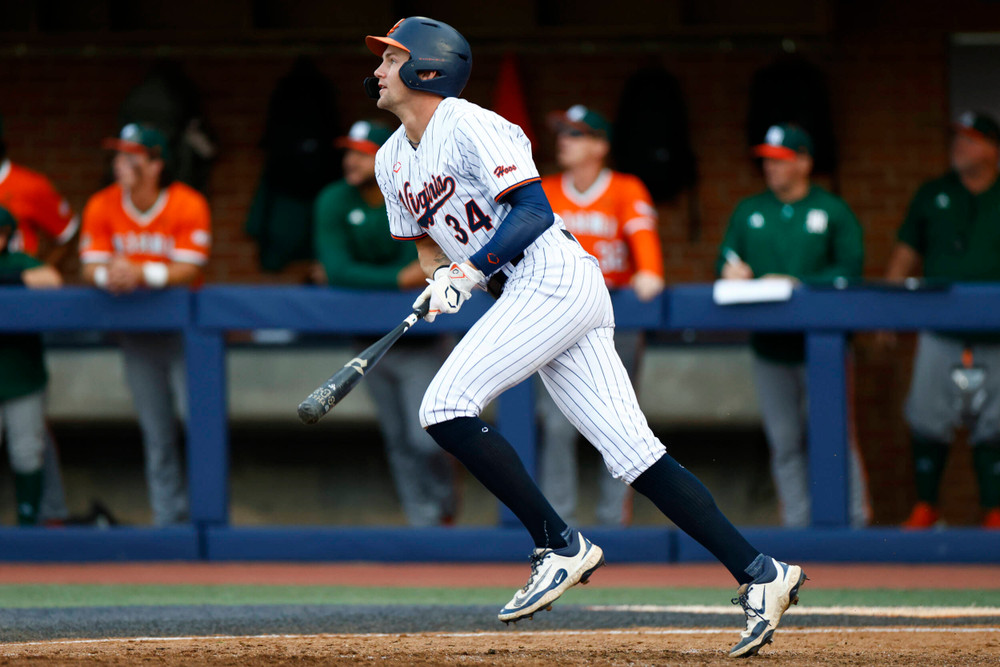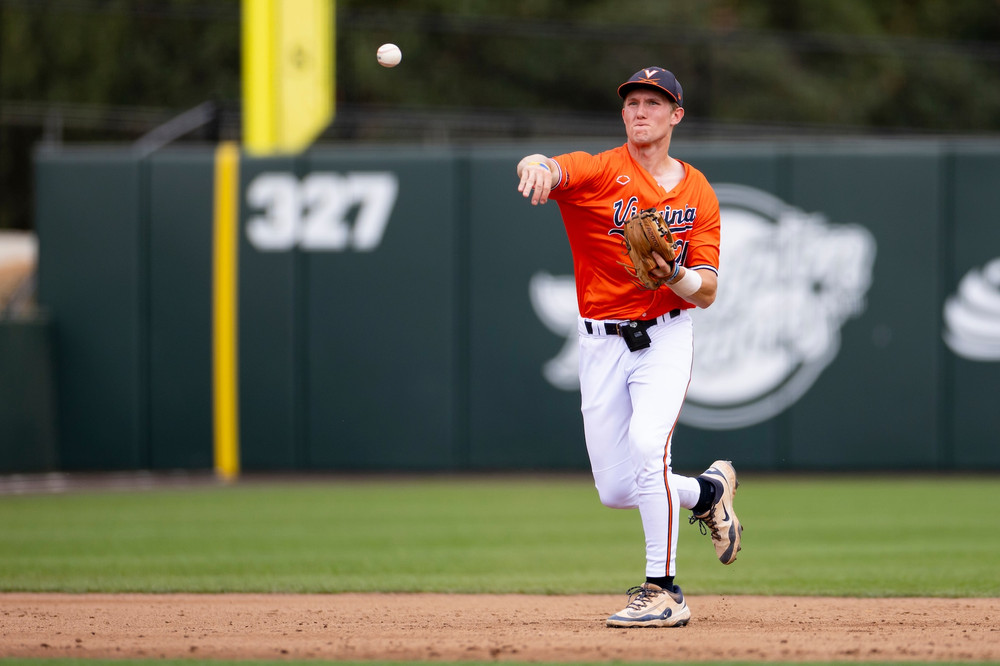Baseball is coming ⚾️#GoHoos https://t.co/Q9aEO3aqFV
— Virginia Baseball (@UVABaseball) October 13, 2025
Hoos Meshing Well at Disharoon Park
By Jeff White (jwhite@virginia.edu)
VirginiaSports.com
CHARLOTTESVILLE, Va. — The University of Virginia’s baseball roster for 2026 is made up of players who can be divided into five distinct groups.
About a dozen players who were at UVA last season remain in the program. About a half-dozen others transferred from Duke to UVA this summer, including slugger AJ Gracia, pitcher Henry Zatkowski and infielder Noah Murray. Several of the Cavaliers’ freshmen originally signed with Duke last fall expecting to play for Chris Pollard in Durham, N.C. Other first-years signed with UVA last fall expecting to play for Brian O’Connor in Charlottesville.
And then there are the transfers who played last season at Davidson, Rider, Western Kentucky, Eastern Michigan, Virginia Tech and Indian River State, respectively.
“I worried over the summer about that blend,” said Pollard, whom Virginia hired in June to succeed O’Connor as head coach. “I worried about it being kind of Duke guys versus UVA guys, new guys versus returning guys, Coach Pollard’s guys versus Oak’s guys. And it was actually the very first thing that I addressed when I got up in front of the guys in our initial team meeting. I said, ‘I just want you to hear this. There are no Duke versus UVA guys. There are no new guys versus returning guys. We are all UVA baseball, with a common goal to get this program to Omaha.’ ”

As it turns out, Pollard need not have worried. “That piece dissolved very quickly, because these guys meshed really, really well,” he said. “And so much of the credit, really all the credit, for that goes to the leadership that’s been provided” by the players back from UVA’s 2025 team.
That group includes Eric Becker, Harrison Didawick, Antonio Perrotta, Kevin Jaxel, Dean Kampschror, Matt Augustin and Tommy Roldan. “Those guys have been awesome,” Pollard said. “Their buy-in to the new staff and the way they’ve worked hard to integrate this whole group together has been remarkable.”
Didawick, who’s in his fourth year in the UVA program, said the situation was “obviously a challenge, but I think the coaches have done a great job of making it as easy as possible and blending us together. It’s honestly so easy, because all these guys have played high-level baseball before. We’re all humble, confident guys, and we’re just having a lot of fun together and meshing well.
“It’s definitely a different experience. I’ve been on three [other] teams here, and I haven’t had an experience quite like this.”
Neither has Becker, but on a recent Wahoo Central Podcast he said he’s “super excited to be here with all the guys and creating new relationships and going after this new challenge ahead of us.”
Some of the players who became UVA teammates this summer already knew each other, including Becker and Gracia. Each attended high school in New Jersey—Becker at Don Bosco Prep, Gracia at Ranney—and they’ve battled each other and been friends for years.
They traveled to Japan together this summer, playing for USA Baseball’s Collegiate National Team, “and we got closer there,” Becker said.
Duke recruited Becker when he was in high school, so he was familiar with Pollard before the coaching change at UVA. “So it was kind of easy talking to him,” Becker said. “And then talking to guys who have played for him, guys like AJ, everyone who has played for him loved him and the rest of the coaching staff. So I’m super excited and pumped to play for them.”
Pollard is a Lynchburg native who grew up in nearby Amherst County and attended Virginia Episcopal School. He came to UVA after 13 seasons at Duke, where he won a program-record 420 games.
A graduate of Davidson College, Pollard spent three years an assistant coach at his alma mater before getting his first head job, at Pfeiffer College in North Carolina. In 2004, he moved to Appalachian State and stayed there as head coach for eight seasons.
In June 2012, Appalachian State defeated UVA in the NCAA regional at what was then known as Davenport Field. Later that month, Duke hired Pollard as its head coach.
Back then, Pollard said, putting together a roster wasn’t so challenging for a new coach.
“You felt like you had time to get to know those kids [already in the program], and that was the group you were going to coach,” Pollard said. “I think that summer of 2012, we only made one or two total additions to the roster. And so it was essentially the returning team plus the incoming class. There was no [transfer] portal, there were no decommitments. If you were an incoming guy, you got to know the new coach and hoped it worked. I think the differences are stunning, candidly, just that our whole landscape has changed that much. It’s not a big chunk of time, when you think about it.”
After 22 seasons at Virginia, O’Connor left in early June to become head coach at Mississippi State. Several UVA players followed him to Starkville, Miss., and others transferred elsewhere. Pollard had no time to ease into his new position, but he and his staff succeeded in putting together a roster that should keep the Cavaliers among the ACC’s top programs.
It helped, Pollard said, that player movement is common in college baseball these days. Some of his current players “have changed high schools two or three times before they get here,” he said. “They almost certainly changed travel ball organizations a handful of times before they get here. A lot of these guys had already transferred once or multiple times before they joined our program. So I do think that student-athletes nowadays view this whole process more on a year-to-year basis, for better or for worse, but it probably does help with assimilation. But I would say again that the job by our veteran upperclassmen has been remarkable.”
Didawick said joining forces with players who previously suited up one for Virginia’s counterparts in the ACC hasn’t been a problem.
“I think rivalries are with the fans more than anything,” he said. “I think no matter who you’re playing against, you have a lot of respect for them. We have a lot of respect for Duke. They’re obviously a great team, great players, great coaches. I’m just glad they’re with us now. It’s a lot of fun.”

Harrison Didawick
Five members of Pollard’s staff also were with him at Duke—pitching coach Brady Kirkpatrick, hitting coach/recruiting coordinator Eric Tyler, infield coach/recruiting coordinator Derek Simmons, director of recruiting Brian Sakowski and director of player development John Natoli—and that’s accelerated the transition at UVA.
“It has been more comfortable in terms of just being able to move at a quicker pace, having a comfort level in our communication style with each other,” Pollard said.
Former UVA pitcher Wes Arrington, who graduated from the Covenant School in Charlottesville, joined the staff this summer as assistant director of operations and player development.
“I can’t tell you how awesome Wes has been,” Pollard said. “Huge addition and tireless worker. Knows the program, knows the area.”
Pollard originally planned to hire a UVA alumnus as director of operations. Once Arrington joined the staff, however, “then the thought was, well, OK, let’s get somebody on board that maybe brings recruiting ties and recruiting value,” Pollard said.
That job went to Casey Scott, who came to UVA after five seasons as head coach at Bishop Verot Catholic High School in Fort Myers, Fla. Scott has served as manager and pitching coach for USA Baseball’s under-15 national team, and he “brings a lot of relationships along with him that have been really, really positive,” Pollard said. “Not to mention he’s just a hard worker and a good guy and throws great batting practice.”
With so many players unfamiliar with Pollard’s system, the staff has focused this fall on “teaching team concepts and getting on the same page with verbiage, the terminology, positioning,” he said. “I look out sometimes in our infield and when I say something, Noah Murray’s the only guy that’s heard it before. And so it’s new to everybody, whether you’re a veteran or whether you’re a young guy, and it’s meant sort of going over and re-going over things.
“That part’s been a little bit slower than maybe I anticipated, but it’s cool to see it starting to click. You start to see signs like, OK, these guys are getting it. And so that part’s been more of an emphasis and taken a little bit more time, but at the same time, I start to see guys figuring it out.”
Fall Ball, anybody? 🍂⚾️#GoHoos pic.twitter.com/QcGD7Flp50
— Virginia Baseball (@UVABaseball) August 28, 2025
This is a team with tremendous potential, Pollard said, but much of that is untapped.
“There is a high level of talent,” Pollard said. “But if you really start to drill down into it, there aren’t a ton of guys that have really done it at this level.”
Becker, Gracia, Didawick and Zatkowski have all distinguished themselves in the ACC. Otherwise, though, “there aren’t a ton of guys when you start really looking and saying, ‘Who’s been a performer at this level?’ ” Pollard said.
“We’ve pitched better than I thought we would. I feel like there’s more to dream on from a pitching side than maybe I anticipated coming in. That said, we don’t have a lot of really defined roles yet. There’s not a lot of guys with starting experience, but a lot of guys with good stuff. And I think by and large, except for a handful of freshmen, who always seem to struggle to throw strikes, this group’s done a good job of being in the zone with good stuff. I think our outfield and our outfield depth has looked good. I think we’re developing good depth behind the plate. I think the thing that scares me is we just don’t have depth in the infield.”
UVA’s second fall exhibition game is Sunday at 1 p.m. against Navy at Disharoon Park, and admission is free for fans. The team’s Fall World Series is scheduled for Oct. 23-25 at the Dish.
Pollard and his wife, Stephanie, have purchased a house in Ivy, and he’s looking forward to settling in there. He’s already at home at Disharoon Park.
“The care that this community and the UVA baseball family have for this program is striking,” Pollard said. “That part’s been a lot of fun and humbling at the same time. And obviously the other biggest difference is just being able to show up at this stadium every day and have all of these resources from a training perspective: the indoor hitting facility, the weight room here inside the stadium, the locker room on site, coaches’ offices here together. Our connectivity is better than it’s ever been, and so that part’s been really good.”
To receive Jeff White’s articles by email, click the appropriate box in this link to subscribe.

Eric Becker

